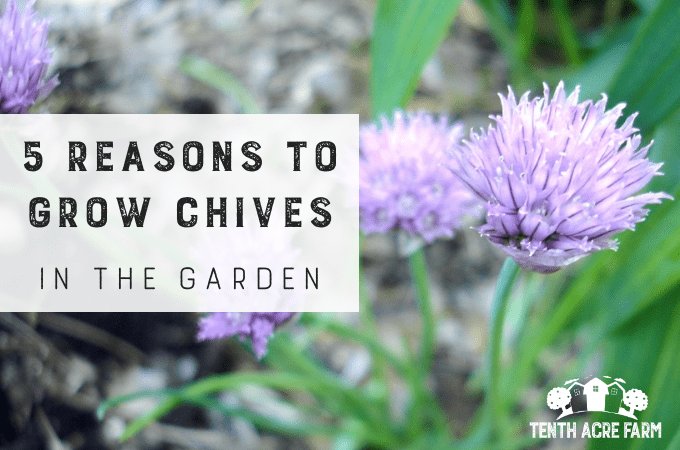Chives are a delicious and useful herb to grow in the herb garden, vegetable garden, and food forest. Here are five benefits of chives in the garden.

This page may contain affiliate links. Please read my disclosure for more info.
The Benefits of Growing Chives
This herb (Allium schoenoprasum) is in the allium family, which includes onions, garlic, leeks, shallots, ramps, and many more.
I love seeing the pop of delicate purple around my yard when chives are in full bloom during late spring. The following are five reasons why I like to grow this herb.
1: They have edible leaves and flowers with a mild taste.
A staple in the culinary herb garden, this herb has an onion scent and a mild onion flavor. It is often used interchangeably in recipes that call for green onions (also called scallions).
Growing up, I remember eating chives on a famous fast food restaurant’s baked potato with sour cream. My favorite potato chips—and chip dip—were sour cream and chives.
The things kids can eat without gaining a pound!
Roasting potatoes in chive butter is exquisite. Also, I love the idea to host a potato bar party with chives as an essential ingredient.
The uses for this herb go beyond sour cream and potatoes, however.
Take advantage of this versatile herb in the early spring when its flavor is the most potent.
Add it to salads, omelettes, cottage cheese, and roasted vegetables. There’s no need for measuring, just toss a handful of the chopped leaves into whatever you’re making to spruce it up.
Savory muffins with kale and chives, anyone?
Chives can also be dehydrated for use throughout the winter, although the flavor will not be as potent. Just chop and dehydrate them at your oven’s lowest setting, or in the dehydrator until brittle. In my dehydrator, it takes around two hours.
Did you know that the blossoms are edible, too? I love to trim the purple petals over salads for a pop of color and a hint of onion-y flavor. Check out more edible blossoms to add to your next meal.
Try equal parts chive blossom vinegar and olive oil as your salad dressing. Mmmmm.
2: Chives make a deer-resistant ground cover.
As a clumping, grass-like plant, they’re attractive in the edible landscape and can quickly fill empty spaces. Try substituting them for the standard landscape plant called Liriope.
Chives are even deer-resistant and can take occasional foot traffic.

Tired of generic permaculture design advice that you can’t apply to your specific goals? If so, check out my Permaculture Design Program and get the tools and support needed to create and implement your own permaculture design.
3: They attract pollinators.
As an important, late-spring nectary, chives feed pollinators and attract them to the garden.
In general, it’s important to provide food and shelter for pollinators, and I always provide lots of plants for them. In this way, the mini-ecosystem reduces my work in the garden. More pollination means better fruit set.
4: Chives deter pests.
Because of their onion-y scent, chives (and any other member of the Allium family) help repel pests that do not like the strong scent. Try companion planting with chives at the edges of your permaculture vegetable garden as well as under fruit trees.
See: How to Build a Fruit Tree Guild and Planning a Cherry Tree Guild.
Here are some other plants that repel pests as well as some additional tips on preventing pests.
5: They are a good fertilizer.
According to Edible Forest Gardens, chives are a rich source of important nutrients for growing crops. Use the chopped leaves as a green mulch under important crops to fertilize. This is one reason why I plant chives in my strawberry bed or grow them as an understory in the food forest.

Green clippings from chives make a nutrient rich mulch in the strawberry patch.
Here are more benefits of growing chives.
Ready to Get Growing?
You can see how useful this herb can be the garden, in addition to being a delightful culinary herb. This perennial herb grows best in USDA hardiness zones 3-9.
Pick up some plants at your local garden store, or grow them yourself. They’re really easy to grow from seed! Here are some more details on growing chives.
Once you have chive plants growing, let the flowers go to seed and you’ll find surprise chive plants around your yard for years to come. Alternatively, let the seed heads dry, and collect the seeds to sow them where you’d like.
What’s your favorite reason to grow chives?
READ NEXT:






Ashley Hetrick says
I love chives and they’re planted all over my garden for both me and the bees, but I didn’t know they were a nutrient accumulator. One more reason to love them. Thanks!
Amy says
Your garden sounds lovely 🙂
Liz says
I didn’t know they accumulated nutrients either. I have them in a few parts of the garden, and they took over an area where the soil is terrible hard clay, but they come back every year and I do nothing to them…Amy always has some great little tidbit that I didn;t know.
Karen says
You had me at “potato bar party.” 🙂 Who knew chives did all that? You’ve inspired me to try my hand at growing some from seed. Hopefully my strawberries will thank me later. Thanks Amy!
Amy says
I can’t wait to hear how it goes for you!
Laureen van Lierop says
Our back deck doesn’t come down fully to the ground and underneath is gravel. I have a row of chives there, they seem to like the poor soil conditions, it is right underneath the kitchen door for easy access and the flowers look charming against the wood. So I guess I use them there mostly as a screen against ugly.
Amy says
That sounds like a great use for chives!
Chris says
I had no idea that I could use chives as a mulch. Thanks. I have over 10 bushy chive plants and they are kind of strawy this time of year. I never thought to chopped them down and toss them around the garden. I bet they’d deter those cabbage butterflies, too. Thanks for the idea.
Maren says
I had a chive plant given to me and it never flowered like that. I will have to give chives another try!
Amy says
Chive plants usually take a year or two to come into their own. Also, they do enjoy rich, fertile soil. In areas with poor soil, a tiny bit of shade will keep them protected while they develop resilient roots. They are certainly worth another try 🙂
Arlene says
Another reason to grow chives: they are so hardy! They are among the first plants to poke threw snow and start growing in the Spring. We live in fairly mild winters (days warm a bit above freezing) and they’ll grow all winter given a bit of water and sun. And if you don’t eat all the blooms, you’ll get plenty of fertile seeds!
Patty Bellin says
Chop your chives and make ice cubes with them. Save in your freezer and when you need to add to soups or stews, just toss one or two into the pot.
M. says
I love chives for your five reasons AANNDD the blossoms that are so very pretty!
Bronwen says
I don’t understand why you guys suggested substituting chives for the Liriope. This is a non-native plant…
Amy says
Non-native to where? Chives are native to North America. Also, they are edible, and as this website is about growing food, chives are a nice edible landscape plant.
Heidi Cullen says
My garden has changed a lot in the last year and is producing far more successes all because of your ideas. I had what I called ‘the slag heap’ which was a dump for all my organic matter. It was about 5ft tall x 5ft wide and although I covered it in nasturtiums each year it always looked a mess. This year I had a raised bed installed in my shady garden and used all the slag heap compost to fill it. The bed is now full of healthy looking plants and I have planted up the old slag heap with a yew tree, aquilegias, foxgloves, dicentra and a hydrangea. The nasturtiums coming through are just a little bonus for the salad bowls. Because of you I have grown yarrow, had success for the first time with lavender and sage seeds and started harvesting my spring onions, garlic, celery, carrots and red onions from growing the kitchen waste. Today I will be planting my chivelets in my strawberry pots. All this in a concrete and pot garden in a town in Devon. Thank you.
Amy says
Heidi, thanks so much for sharing! Your story warms my heart. I’m so glad to hear that you’re connecting to your space and having a rewarding experience in your garden. 🙂